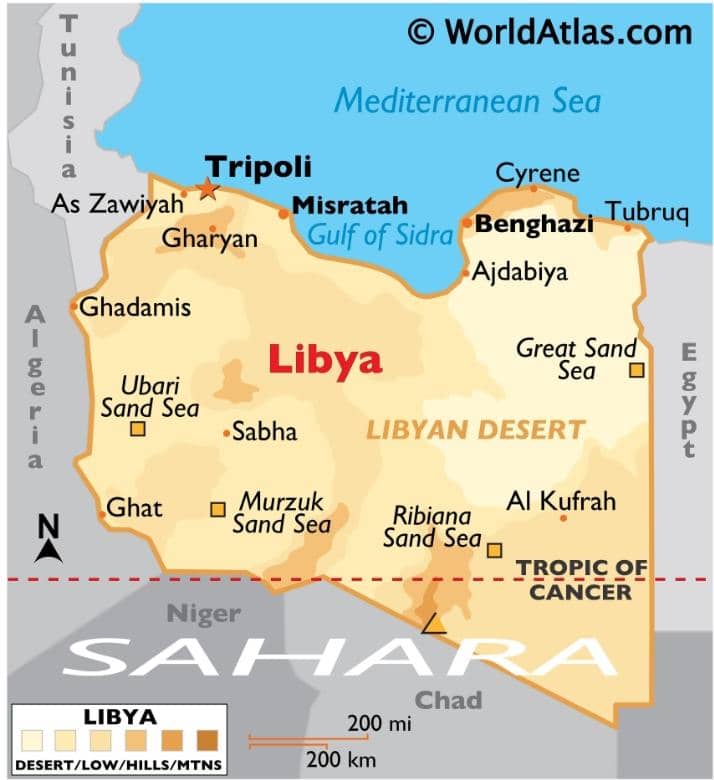Libya, a country located in the heart of North Africa, is bordered by six nations: Tunisia, Algeria, Niger, Chad, Sudan, and Egypt. This vast and diverse region is home to a rich cultural heritage, unique geography, and a complex history.
Libya is the fourth-largest country in Africa, covering an area of approximately 1.8 million square kilometers. It is bounded by the Mediterranean Sea to the north, Tunisia and Algeria to the west, Niger and Chad to the south, and Egypt and Sudan to the east.
The country is almost entirely covered by the Sahara Desert, making it one of the driest regions in the world. Despite this, Libya has a few areas of fertile land, including the Al-Jifārah Plain in the northwest and the Barce Plain in the east, which support agriculture and urban development.
The Al-Jifārah Plain covers about 10,000 square miles and is home to most of Libya’s population and its largest city, Tripoli.
The Nafūsah Plateau, a limestone massif, stretches from Al-Khums on the coast to the Tunisian border at Nālūt. The Akhḍar Mountains, located in northeastern Libya, rise steeply from the coast and stretch about 20 miles inland, reaching elevations of nearly 3,000 feet at their highest points.
Libya has no permanent rivers, but it is rich in underground water. The Great Man-Made River project, completed in 1991, taps into these reserves to provide fresh water to the cities. The country’s numerous wadis, which are filled by flash floods during the rains, quickly dry up or reduce to a trickle.
Libya’s climate varies significantly depending on the region. The coastal areas, including Tripoli and Benghazi, have a Mediterranean climate with mild winters and hot summers. The interior, however, is extremely hot and dry, with temperatures often exceeding 45°C (113°F) in the summer. The desert regions experience extreme temperatures, with temperatures dropping to below freezing in the winter.
Libya’s population is predominantly Arab, with an estimated 10% being Berber. The Berbers are considered the earliest inhabitants of the country, arriving around 1200 B.C. Arabs began settling in Libya around 700 A.D., following the rise of Islam.
The majority of Libyans speak Arabic, and nearly 97% of the population is Muslim. The country also has small populations of Greeks, Egyptians, and Italians.
Libyan culture is rich and diverse, with traditions in weaving, embroidery, metal engraving, horse racing, folk dancing, and soccer being popular activities.
The cities of Tripoli and Benghazi are hubs of cultural and economic activity, with many teams and events that locals enjoy.
Libya’s economy is heavily reliant on oil and gas exports, making it a major global oil producer. However, the country’s economy has been severely impacted by the civil war and the subsequent instability.
The value of the Libyan dinar has decreased significantly, and the economy continues to struggle.
Libya is a country of contrasts, with a diverse geography, a rich cultural heritage, and a complex history. Its challenges are numerous, but its people and their resilience continue to drive the country forward.
As Libya navigates its path towards stability and prosperity, it remains a country of great interest and importance in the African region.

